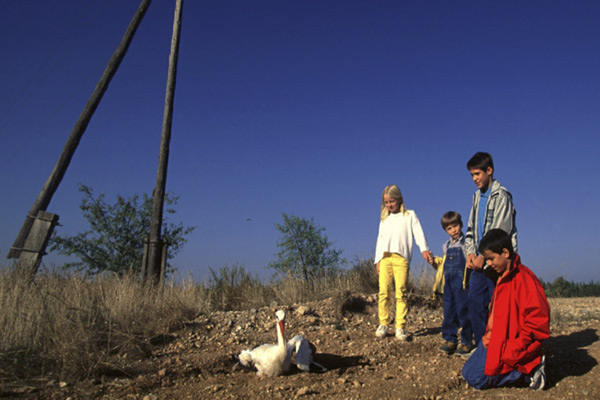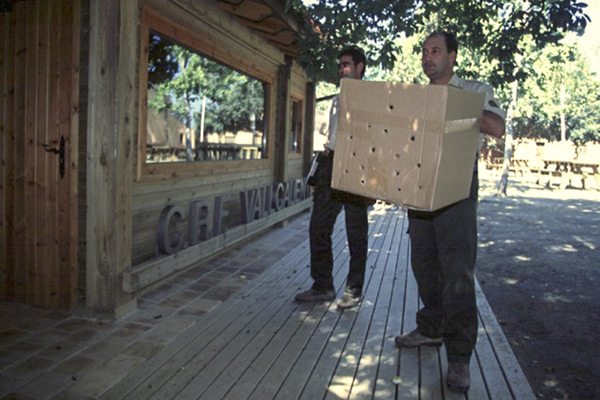Amés dels projectes actuals de conservació i desenvolupament sostenible, des de Trenca també duem a terme altres actuacions ambientals.
WRC Vallcalent

Trenca was born in 1998 as an association of friends of the Wildlife Rehabilitation Centre of Vallcalent (belonging to the Departament de Medi Natural de la Generalitat de Catalunya / Environment Department of the Autonomous Government of Catalonia). Since then, there has been a continuous, close and diverse collaboration between Trenca and the Centre, mainly through volunteers, helping with the different tasks carried out in Vallcalent.
The Wildlife Rehabilitation Centre of Vallcalent works as a small hospital for wildlife.Many people find an injured or sick wild animal, catch it and bring it to the Wildlife Centre of Vallcalent.
Different authorities, such as the agents rurals (rural agents), bring some legally protected species to the Centre, that sometimes come from interventions and seizures.
After having already passed through the clinic and rehabilitation facilities, those birds that are cured and rehabilitated stay finally in large excercise facilities, in order to gain strength before being released into the wild.
The Wildlife Centre of Vallcalent does not only works as a small hospital for wildlife. Captive breeding of local legally protected species is also carried out at the Centre facilities. The two most outstanding breeding projects are the one of the Bearded Vulture (Gypaetus barbatus) and the one of the Lesser Grey Shrike (Lanius minor).
Parallel with tasks focused on wildlife, all that work and organisation is used at the Wildlife Centre of Vallcalent to enhance social awareness about the loss of biodiversity and the need to preserve it. On the one side, this is done indirectly, through the care provided to people who is bringing injured or sick wild animals to the Centre, and also directly, through environmental education activities, even with specific educational programs. Of all of them, the most important was Fauna and Habitat (1999-2005), carried out along with Trenca.
Photos: © Jordi Clariana & Trenca
Barn Owl

Populations of Barn Owl are suffering a severe reduction around the world. The intensification of agriculture has led to the abusive use of pesticides to kill insects and rodents pests, causing Barn Owl preys poisoning, as well as direct killing of this and other nocturnal birds of prey by poisoning.
Another problem is the high mortality rate of barn owls on roads, as a result of the construction of an even faster ways as well as vehicles speeding.
The Wildlife Centre of Vallcalent (belonging to the Departament de Medi Natural de la Generalitat de Catalunya/Environment Department from the Autonomous Government of Catalonia) and Trenca collaborate on the captive breeding of the Barn Owl (Tyto alba). The primary objective is to release chicks born in captivity by using a technique called hacking.
Through this action, it helps to recover the population of this nocturnal raptor where it lived and is now gone. On the other side, keeping in mind the collaboration of people and entities that volunteer for hacking, an educational line has been set up to raise awareness among the population about the Barn Owl conservation, as this bird is very beneficial to agriculture.
Photos: © Albert Porté, Albert Gispert & Trenca
Peregrine Falcon

In order to help in controlling pigeons in the city of Lleida and in raising awareness in the population of the city on wildlife conservation, Peregrine Falcon chicks have been released in the Seu Vella of Lleida.
The released falcon chicks were always born in captivity at the Wildlife Centre of Vallcalent. For the reintroduction, the hacking technique has been used.
By using the hacking technique, Peregrine Falcon chicks aged 30 days (by that age they can eat by themselves, tearing flesh with their talons and beak) were left in a artificial nest located on the Torre de los Exorcismos (Exorcisms Tower) of the Seu Vella.
The nest box remained closed for about 10 days, but the peregrine falcon chicks could see the outside through a grid. During that period of time, falcon chicks were fed artificially, leaving them food every day. Once they were completely feathered, the grid was removed so that they could go outside and start their adaptation to the urban habitat.

During that period of time when the reintroduction tasks were carried out, two 2,5 m high informational posters were present in the Seu Vella of Lleida. Visitors like them a lot, and they could also watch, right there, live, what was going on with the Peregrine Falcon chicks that were in the hacking facilities on the Exorcisms Tower.
Despite the fact that we did not get peregrine falcons to breed in the Seu Vella towers, the area is used by the species as a wintering place.
Photos: © Jordi Clariana & Trenca










